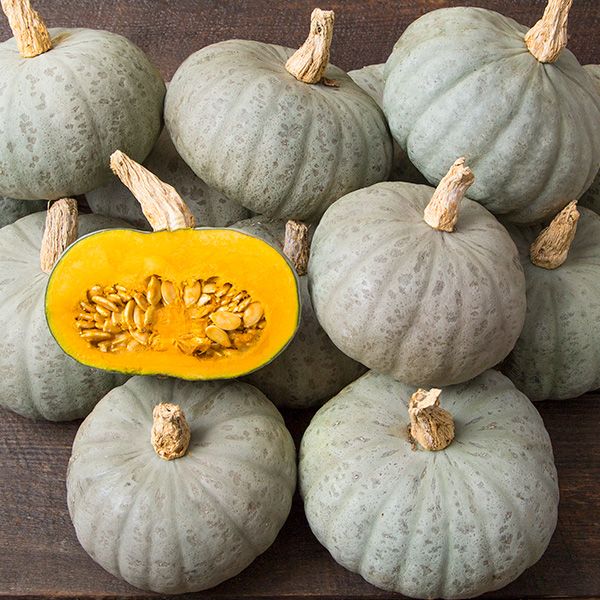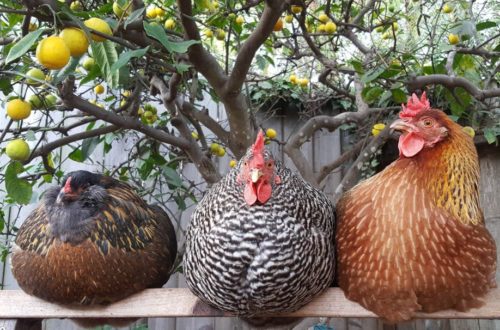
28 Best Winter Squash and Pumpkin Varieties to Grow
Butternut, acorn, delicata… There are so many kinds of decorative and edible winter squash to grow, and even more interesting varieties within each type! Come explore our top 28 popular and noteworthy winter squash varieties – including pumpkins, spaghetti squash, kabocha squash, and more.
In addition to their unique appearances, different winter squash varieties offer their own distinct flavor profiles, culinary uses, fruit size, growth habits (bush vs vining), storage potential, days to maturity, and natural pest or disease resistance. Ranging from highly ornate to simple and delicious, there is something for every gardener on this list.
Need tips on growing winter squash and pumpkins? Check out our full seed-to-table Grow Guide here.
Disclosure: This post contains affiliate links, including to High Mowing Organic Seeds, our favorite small business to buy certified organic garden seeds from. Browse the complete selection of winter squash varieties offered by High Mowing here.
Butternut Squash Varieties
Pumpkins aside, butternut squash are arguably the most common and popular type of winter squash – and for good reason! With its sweet, nutty, beautiful orange flesh, butternut squash is ideal for baking, roasting, soups, sauces, and more. It pairs equally as good with sweets and cinnamon spices as it does with savory herbs like sage, garlic, and thyme, and can be used interchangeably in recipes that call for pumpkin. Butternut also offers a high flesh-to-cavity ratio, exceptional storage life, and are highly resistant to squash vine borers! There are dozens of different butternut squash varieties, but here are my top four:
- Nutter Butter Butternut. This is our favorite butternut squash variety. We harvested 28 squash (just over 60 pounds) from just TWO plants last year! It’s described to be “reliably mature in regions that have trouble ripening butternuts” and has some tolerance to powdery mildew – both great for our cool coastal climate. 90 days to maturity. Vining habitat. Get seeds here.
- Waltham Butternut. A classic large butternut squash variety with a long neck and small seed cavity. The yellow orange flesh is sweet, rich, and nutty tasting. Great long-term storage. 100 days to maturity. Vining habitat. Get seeds here (or here).
- Autumn Frost Butternut Squash. A gorgeous specialty butternut with a unique frosted appearance and rich earthy flavor. Highly resistant to powdery mildew. 100 days to maturity. Vining. Get seeds here.
- Honeynut Butternut. Petite personal-sized butternut squash with a classic butternut shape, dark tan skin, and great tasting flesh. Good resistance to powdery mildew. 110 days to maturity. Vining habitat. Get seeds here (or here).


Pumpkin Varieties
Pumpkins: the quintessential winter squash variety for fall decor – and drool-worthy seasonal baked goods! All pumpkin varieties are technically edible, though some “jack-o-lantern” types are best left for carving or ornamental use. On the other hand, most pumpkin varieties are absolutely delicious. They’re also loaded with vitamin A, C, antioxidants, and fiber. Browse even more unique pumpkin varieties here, and don’t miss our list of pumpkin (and butternut) recipes at the end of this post!
- New England Pie Pumpkin. Also known as “sugar pie pumpkins”, these petite round heirloom pumpkins have flavorful, stringless flesh with the ideal texture for baking. 105 days to maturity. Vining. Get seeds here.
- Cider Jack Pumpkin. Medium sized Jack O’ Lantern type (10-14 pound fruits) with smooth skin and long stem make it great for carving. Some resistance to powdery mildew. 90 days to maturity. Semi-bush habitat. Get seeds here.
- Cinderella Pumpkin. A whimsical French heirloom pumpkin with large, flattened red-skinned fruit (15 to 20 pounds) with deep orange flesh and a strong sweet flavor. Edible and highly ornamental. 99 days to maturity. Vining. Get seeds here (or here).
- Pie-Pita Hulless Pumpkin. This pie pumpkin variety produces already-shelled (hulless) pumpkin seeds inside (aka pepitas) – making it ideal to use for its flesh AND easy edible seeds. Petite 2 to 3 pound fruit. 100 days to maturity. Vining. Get seeds here.
- Musquee de Provence (aka Fairytale). Stunning ribbed, flat heirloom pumpkin variety that grows 14 to 40 pounds. Tan, muted orange skin and thick, deep orange moderately sweet flesh. Sold in cut wedges in French markets for cooking. Highly decorative and edible. Long storage ability. 125 days to maturity. Vining. Get seeds here.
- Jarrahdale Pumpkin. Silvery-blue pumpkin with deep ridges that reaches 6 to 12 pounds in weight. Can be used as decor, carved, and even baked. Orange, stringless flesh is sweet and nutty in flavor. Good long storage ability. 100 days to maturity. Vining. Get seeds here.
- Red Warty Thing. Unique 10-20 pound fruit with incredibly bumpy, red-orange skin and good flavored flesh with nice texture. Can be used as decor, carved, or eaten once the fall holiday season has passed. 110 days to maturity. Vining. Get seeds here.



Acorn Squash Varieties
Acorn squash is a small, round, scalloped winter squash variety. It is prized by Indigenous peoples for its long storage life, ability to cook whole, and versatile uses. Acorn squash flesh is mild and buttery, pairing with both savory and sweet flavors and seasonings. The petite size (2-3 pounds) makes one fruit an ideal meal for two. The generous-sized center cavity is perfect for stuffing with other filling ingredients, served right in its own shell.
- Sweet Reba Acorn Squash. REBA stands for “Resistant Early Bush Acorn” – describing this highly disease-resistant, early bush variety of acorn squash. It produces bountiful yields of uniform two pound fruit with dark green skin and dark yellow flesh. 90 days to maturity. Bush. Get seeds here.
- Table King Acorn Squash. An even earlier-maturing acorn squash variety, ideal for short growing seasons or late planting. Two pound fruit with dark green skin, bright yellow flesh, and sweet nutty flavor. 75-80 days to maturity. Compact 4′ vines, good for small spaces. Get seeds here.
- Sugarbush Acorn Squash. Round 2 to 3 pound fruit with dark green skin and exceptionally sweet golden orange flesh. This acorn squash variety offers high resistance to powdery mildew and a small seed cavity. 90 days to maturity. Compact bush type. Get seeds here.


Delicata Squash Varieties
Delicata squash are oblong cylindrical fruits with cream to yellow-orange skin and green stripes. Unlike other winter squash varieties, delicata has exceptionally thin edible skin, so peeling isn’t necessary! This makes it especially popular for quick and easy preparation, roasting, and even used on salads. Despite the thin skin, delicata squash should still last a couple months in dry storage post-harvest if stored properly. The flavor of delicata squash is often described as a cross between butternut squash and sweet potato, sweet and tender.
- Classic Delicata Squash. Vining plant that produces oblong, uniform 1 to 1.5 pound striped fruit with superbly tender, sweet flesh and skin. 95 days to maturity. Get seeds here.
- Honeyboat Delicata. Claimed to be the “sweetest squash in existence”. Long 1 to 1.5 pound fruits have the classic green striping of delicata but with a much more orangey-copper colored skin compared to the yellow that is typically found. Stores well and the sweetness holds up through storage. 100 days to maturity. Vining. Get seeds here.
- Bush Delicata. 1.5 to 2 pound cream-skinned fruit with green stripes that turns more yellow as it cures. Sweet, nutty flavor with hints of butter and brown sugar. Compact plants only spread 4-6 feet and have some resistance to powdery mildew. 100 days to maturity. Semi-vining. Get seeds here.

Hubbard Squash
Hubbard squash are a large, interesting, pear-shaped type of winter squash. It’s very ornate for fall decor! Like most winter squash varieties, Hubbard squash flesh is sweet and starchy but can also sometimes be a bit grainy – so it’s better for purees, baking, or soups than eating roasted on its own. Note that Blue Hubbard squash is highly attractive to squash bugs and vine borers. So much so, it’s often grown as a trap crop.
- Baby Blue Hubbard Squash. A smaller version of the unique teardrop-shaped blue Hubbard squash. 5 to 7 pound fruits with smooth blue-gray skin. This variety’s yellow-orange flesh is sweeter than classic large Hubbard squash. 95 days to maturity. Get seeds here.
- Red Kuri. A red baby hubbard type that bears 3 to 4 pound teardrop-shaped fruit with bright reddish-orange skin, and smooth, sweet, dry orange flesh. This improved variety offers great yields even in cooler climates and shorter seasons. 95 days to maturity. Vining. Get seeds here (or here).


Kabocha Squash
Kabocha squash is a Japanese type of winter squash, with small to medium size squatty fruit that resemble petite heirloom pumpkins. Classic kabocha varieties have dark green skin with yellow flesh, though it also comes in other colors and cultivars. Kabocha’s smooth sweet flesh is very versatile to use in cooking, roasting, baked goods, and as a substitute for other winter squash varieties in recipes, including pumpkin.
- Sunshine Kabocha. Vigorous, compact plants produce slightly flattened 3 to 5 pound globe-shaped fruit. Reddish-orange skin and bright orange flesh with great flavor and stringless texture. 95 days to maturity. Semi-bush. Get seeds here.
- Bagheera. Dark green skin with golden orange flesh that is both rich in flavor and firm in texture. 3 to 4 pound fruits grow on compact high-yielding plants. 95 days to maturity. Semi-bush. Get seeds here.
- Winter Sweet Squash. Uniquely beautiful pale gray-blue kabocha squash. 4 to 5 pound fruits offer complex, sweet, rich flavor that improves after a 2-5 months of storage. Taste test winner, and excellent long storage! 95 days to maturity. Vining. Get seeds here.


Spaghetti Squash
Spaghetti squash is a fun winter squash variety for adults and kids alike. It also makes a great low-carb or gluten-free pasta alternative. Once cooked, spaghetti squash flesh pulls apart into long “noodles” – which can be served right in its own skin like a bowl! Top with butter or olive oil, salt, pepper, and perhaps a sprinkle of parmesan cheese. Yum!
- Classic Spaghetti Squash: Long, oblong yellow 3 to 5 pound fruit with flesh that separates into noodle-like strands when cooked. Very sweet and kid-friendly. 88 days to maturity. Vining. Get seeds here.
- Orangeti Spaghetti Squash: Oblong in shape like traditional spaghetti squash but matures into a dark golden orange in color, inside and out. Early-maturing and high yield potential. 70 days to maturity. Vining. Get seeds here.
- Angel Hair Spaghetti Squash: Prolific vines produce abundant petite squash (1.5 to 2 pounds). When cooked, the squash shreds into extra-fine angel hair squash noodles. 88 days to maturity. Vining. Get seeds here.

Other Winter Squash Varieties
- Burgess Buttercup: Prolific long green vines bear 10 to 12 round squash. Ideal for trellising. Fruit are 3 to 5 pounds each, with green skin and bright orange sweet flesh. 95 days to maturity. Vining. Get seeds here.
- Lakota: Beautiful pear-shaped heirloom squash with mottled bright reddish-orange and green skin. A rare, delicious, and highly-decorative Native American winter squash variety, historically grown by the Lakota Sioux. Sweet and nutty flavor. 85-100 days to maturity. Vining. Get seeds here.
- Pink Banana: Large, oblong fruit that measure 18-24 inches in length and weigh up to 12 pounds. Smooth, light pink skin with sweet orange flesh that can be eaten on its own, used in baked goods, or canning. Aaron used to work at Whole Foods, and these things were a HIT with customers whenever they came into stock. 100-120 days to maturity. Vining. Get seeds here.


That concludes this round-up of awesome pumpkin and winter squash varieties.
Believe it or not, we barely scratched the surface of all the winter squash varieties and options out there. But I hope this list serves as a great starting point, and gives you plenty of ideas and inspiration! Did I miss any of your favorite go-to varieties to grow? Please let us know in the comments, or ask any questions you may have. Also please feel to share this article if you found it useful. Thanks for tuning in, and happy growing!
Don’t miss these related posts:
- How to Grow Winter Squash and Pumpkins: The Ultimate Guide
- Vegan Roasted Sugar Pie Pumpkin 3-Bean Chili
- Freezer-Friendly Homemade Pumpkin Puree Recipe (or winter squash)
- Delicious Butternut Squash Pie Recipe
- Soaked and Roasted Pumpkin Seeds
- Creamy Roasted Butternut Squash and Sage Soup
- Healthy Sourdough Pumpkin Bread Recipe (or Muffins)









2 Comments
Kay
I found a white acorn squash at the store this past winter. It tasted really good! Better than the green ones I’ve had before.
Aaron (Mr. DeannaCat)
Hi Kay, thanks for sharing! We have seen white acorn squash before but we have yet to eat any ourselves, will have to look into varieties and see if any make the grow list.